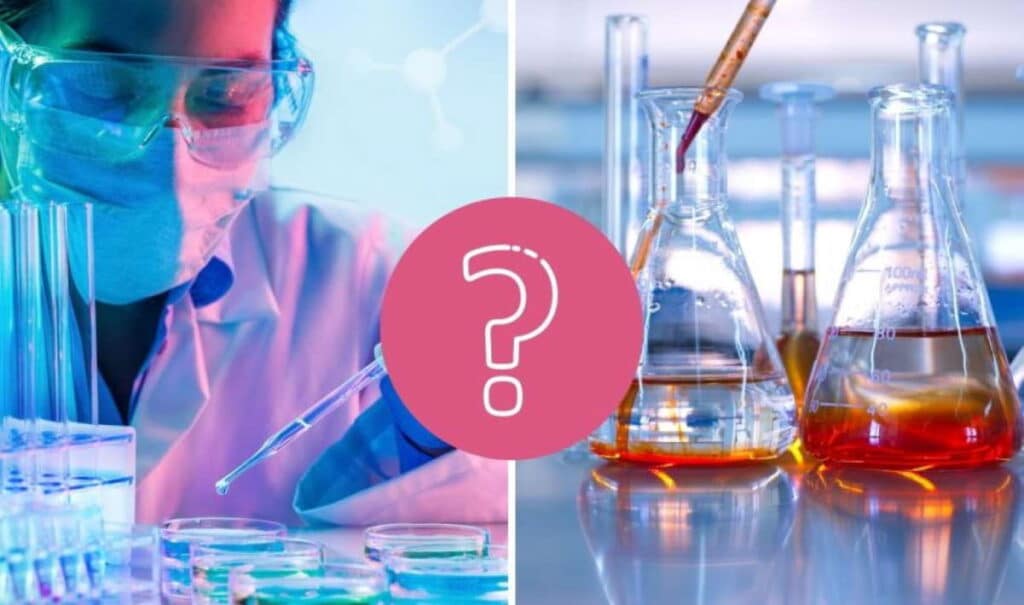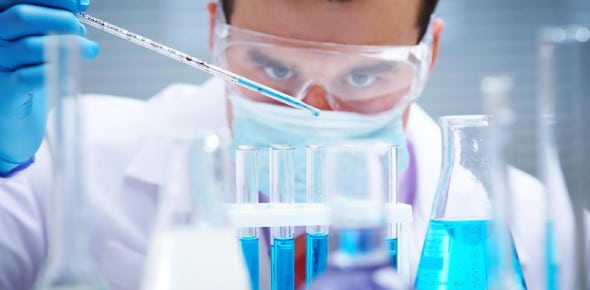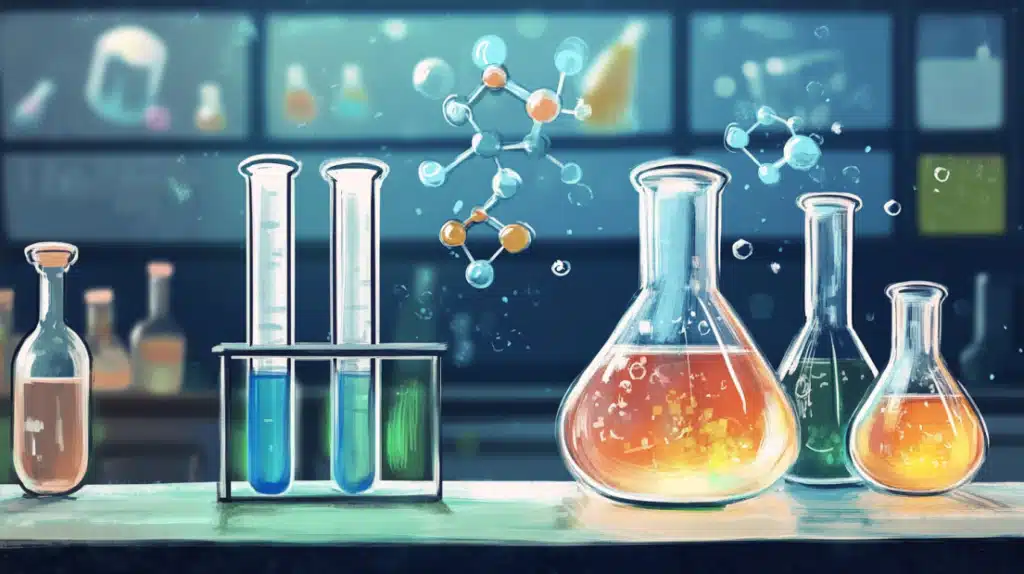Hey there, science enthusiasts! Have you ever felt like your chemistry knowledge could use a boost? I get it.
As a fellow science buff, I know how tricky it can be to keep up with all the elements, reactions, and quirky facts in chemistry. But don’t worry – I’ve got just the thing to help you out.
In this post, I’m sharing over 257+ chemistry trivia questions that’ll make you the star of any science conversation. From basic concepts to mind-blowing discoveries, we’ll cover it all.
Get ready to dive into a fun mix of easy and challenging questions that’ll test your knowledge and teach you new things about the interesting world of chemistry.
Let’s get started!
List of Chemistry Trivia Facts

-
What is the definition of an atom? – The smallest unit of matter that retains the properties of an element.
-
How many protons are in a hydrogen atom? – One proton.
-
Who created the modern periodic table? – Dmitri Mendeleev.
-
What does the atomic number represent? – The number of protons in an atom’s nucleus.
-
Which element has the chemical symbol ‘Au’? – Gold.
-
What are the three main subatomic particles? – Protons, neutrons, and electrons.
-
In which group of the periodic table are noble gases found? – Group 18 (or VIII A).
-
What is the most abundant element in the Earth’s crust? – Oxygen.
-
How many elements are in a period of the periodic table? – It varies, but the longest periods (6 and 7) have 32 elements.
-
What is the atomic number of carbon? – 6.
-
Which scientist discovered the electron? – J.J. Thomson.
-
What is the heaviest naturally occurring element? – Uranium.
-
How many elements are in the periodic table (as of 2024)? – 118.
-
What does the term “isotope” mean? – Atoms of the same element with different numbers of neutrons.
-
Which element is named after Albert Einstein? – Einsteinium (Es).
-
What is the lightest element in the periodic table? – Hydrogen.
-
Who discovered the neutron? – James Chadwick.
-
What are the elements in group 1 of the periodic table called? – Alkali metals.
-
Which element has the highest electronegativity? – Fluorine.
-
Which element is commonly used in the production of batteries? – Lithium.
-
Which element is essential for life but doesn’t appear in the chemical formula for DNA? – Sodium.
-
What is the most electronegative element? – Fluorine.
-
Which element is named after the Latin word for “ray”? – Radium.
-
What is the atomic mass unit (amu) based on? – One-twelfth the mass of a carbon-12 atom.
-
Which element is used in the filaments of old-fashioned light bulbs? – Tungsten.
-
What is the only element that is liquid at room temperature and standard pressure? – Mercury.
-
What type of bond forms between a metal and a non-metal? – Ionic bond.
-
In a covalent bond, what do atoms share? – Electrons.
-
What is the name of the reaction between an acid and a base? – Neutralization.
-
What is a catalyst? – A substance that increases the rate of a chemical reaction without being consumed.
-
What is the name for a reaction that releases heat? – Exothermic reaction.
-
What type of bond exists between water molecules? – Hydrogen bond.
-
What is the chemical formula for table salt? – NaCl (Sodium chloride).
-
What is the process of iron combining with oxygen called? – Rusting or oxidation.
-
What is the name for a reaction that absorbs heat? – Endothermic reaction.
-
What type of bond allows metals to conduct electricity? – Metallic bond.
-
What is the chemical formula for water? – H2O.
-
What is the process of splitting a water molecule using electricity called? – Electrolysis.
-
What is the name for a substance that changes color to indicate pH? – Indicator.
-
In a double displacement reaction, how many products are typically formed? – Two.
-
What is the chemical formula for carbon dioxide? – CO2.
-
What type of reaction occurs when a single compound breaks down into two or more simpler substances? – Decomposition reaction.
-
What is the name for a region of a molecule where electrons are likely to be found? – Orbital.
-
What is the term for a molecule that can form hydrogen bonds with water? – Hydrophilic.
-
What is the name for a reaction where two or more substances combine to form a single compound? – Synthesis or combination reaction.
-
What is the chemical formula for methane? – CH4.
-
What type of bond forms between two non-metal atoms? – Covalent bond.
-
What is the name for a reaction where one element replaces another in a compound? – Single displacement reaction.
-
What is the term for a substance that accepts protons in a chemical reaction? – Base.
-
What is the chemical formula for sulfuric acid? – H2SO4.
-
What is the name for a reaction where heat causes a compound to break down into its elements? – Thermal decomposition.
-
What is the chemical formula for ammonia? – NH3.
-
What are the three basic states of matter? – Solid, liquid, and gas.
-
What state of matter has a definite volume but no definite shape? – Liquid.
-
What is the process called when a solid changes directly to a gas? – Sublimation.
-
What state of matter is plasma? – The fourth state of matter.
-
What is the process called when a gas changes directly to a solid? – Deposition.
-
In which state of matter are particles most tightly packed? – Solid.
-
What is the name for the change from liquid to gas? – Vaporization or evaporation.
-
What is the temperature at which a liquid boils called? – Boiling point.
-
What is the process of a solid changing to a liquid called? – Melting.
-
What state of matter is found in neon signs? – Plasma.
-
What is the temperature at which a solid changes to a liquid called? – Melting point.
-
What is the process of a gas changing to a liquid called? – Condensation.
-
In which state of matter do particles have the most kinetic energy? – Gas.
-
What is the name for the change from solid to gas without passing through the liquid state? – Sublimation.
-
What state of matter is supercritical fluid? – A state with properties between those of a gas and a liquid.
-
What is the process of a liquid changing to a solid called? – Freezing or solidification.
-
What is the temperature at which a substance changes from a liquid to a solid called? – Freezing point.
-
What state of matter is Bose-Einstein condensate? – A fifth state of matter occurring at extremely low temperatures.
-
What is the name for the change from gas to solid? – Deposition.
-
In which state of matter do particles have the least kinetic energy? – Solid.
-
What is the process of a gas changing to a plasma called? – Ionization.
-
What state of matter has no definite shape or volume? – Gas.
-
What is the name for the temperature at which the vapor pressure of a liquid equals the atmospheric pressure? – Boiling point.
-
What is the process called when a substance changes from one state to another? – Phase transition.
-
What state of matter makes up about 99% of the visible universe? – Plasma.
-
What is the term for the pressure exerted by a vapor in equilibrium with its liquid phase? – Vapor pressure.
-
What is a homogeneous mixture called? – Solution.
-
What is the substance being dissolved in a solution called? – Solute.
-
What is a mixture of two or more substances that are not chemically combined called? – Mixture.
-
What type of mixture can be separated by filtration? – Heterogeneous mixture.
-
What is the liquid in which a solute is dissolved called? – Solvent.
-
What is a mixture in which particles of one substance are dispersed throughout another substance called? – Colloid.
-
What is the term for the maximum amount of solute that can be dissolved in a given amount of solvent at a specific temperature? – Solubility.
-
What is a mixture where particles settle out over time called? – Suspension.
-
What unit is used to express the concentration of a solution in moles of solute per liter of solution? – Molarity (M).
-
What is an example of a colloid? – Milk.
-
What is the process of a solid dissolving in a liquid called? – Dissolution.
-
What is a saturated solution? – A solution that contains the maximum amount of dissolved solute at a given temperature.
-
What is the term for a solution that contains less solute than it is capable of dissolving? – Unsaturated solution.
-
What is an example of a suspension? – Muddy water.
-
What is the term for a solution that contains more dissolved solute than is normally possible at a given temperature? – Supersaturated solution.
-
What is the Tyndall effect? – The scattering of light by colloidal particles.
-
What is an emulsion? – A mixture of two immiscible liquids.
-
What is the formula for calculating molality? – Moles of solute per kilogram of solvent.
-
What is a heterogeneous mixture? – A mixture with visibly different components.
-
What is an example of a homogeneous mixture? – Salt water.
-
What is the term for the amount of solute present in a given amount of solution? – Concentration.
-
What is a solution with water as the solvent called? – Aqueous solution.
-
What is the process of separating a solid from a liquid by heating the liquid until it evaporates? – Evaporation.
-
What is an alloy? – A homogeneous mixture of two or more metals.
-
What is the term for a mixture in which one liquid is dispersed throughout another liquid? – Emulsion.
-
What is the process of separating components of a mixture based on their different boiling points called? – Distillation.
-
What does pH stand for? – Potential of Hydrogen.
-
What is the pH of a neutral solution? – 7.
-
What is an acid? – A substance that donates protons (H+ ions).
-
What is a base? – A substance that accepts protons (H+ ions).
-
What is the pH range for acids? – 0 to 7.
-
What is the pH range for bases? – 7 to 14.
-
What is the chemical formula for hydrochloric acid? – HCl.
-
What is the chemical formula for sodium hydroxide? – NaOH.
-
What is the name of the scale used to measure acidity or basicity? – pH scale.
-
What happens to the pH when an acid is diluted with water? – It increases.
-
What is the chemical formula for sulfuric acid? – H2SO4.
-
What is the common name for acetic acid? – Vinegar.
-
What is the pH of pure water at room temperature? – 7.
-
What is the chemical formula for nitric acid? – HNO3.
-
What is the chemical name for lye? – Sodium hydroxide.
-
What is the pH of human blood? – Approximately 7.4.
-
What is the main acid found in car batteries? – Sulfuric acid.
-
What is the chemical formula for carbonic acid? – H2CO3.
-
What is the main component of antacids? – Bases that neutralize stomach acid.
-
What is the pH of lemon juice? – Around 2.
-
What is the chemical formula for ammonia? – NH3.
-
What is the acid found in ants and bee stings? – Formic acid.
-
What is the pH of milk? – Slightly acidic, around 6.5 to 6.7.
-
What is the main acid in stomach acid? – Hydrochloric acid.
-
What is the chemical formula for potassium hydroxide? – KOH.
-
What is the pH of a typical soap? – Around 9 to 10 (basic).
-
What is organic chemistry primarily concerned with? – The study of compounds containing carbon.
-
What is the simplest alkane? – Methane (CH4).
-
What is the general formula for alkanes? – CnH2n+2.
-
What is an alkene? – A hydrocarbon with at least one carbon-carbon double bond.
-
What is the functional group of an alcohol? – Hydroxyl group (-OH).
-
What is the IUPAC name for CH3CH2OH? – Ethanol.
-
What is an isomer? – Compounds with the same molecular formula but different structural arrangements.
-
What is the functional group of a ketone? – Carbonyl group (C=O) not at the end of the carbon chain.
-
What is the smallest aromatic compound? – Benzene.
-
What is the functional group of a carboxylic acid? – Carboxyl group (-COOH).
-
What is the IUPAC name for CH3COOH? – Ethanoic acid (commonly known as acetic acid).
-
What is an ester? – A compound formed from a carboxylic acid and an alcohol.
-
What is the functional group of an amine? – -NH2 group.
-
What is the difference between saturated and unsaturated hydrocarbons? – Saturated hydrocarbons have only single bonds between carbon atoms, while unsaturated have at least one double or triple bond.
-
What is the name of the process that converts alkenes to alkanes? – Hydrogenation.

-
What is the general formula for alkenes? – CnH2n.
-
What is an aldehyde? – A compound with a carbonyl group (C=O) at the end of a carbon chain.
-
What is the IUPAC name for CH3CH2CH3? – Propane.
-
What is a polymer? – A large molecule composed of many repeated subunits.
-
What is the name of the reaction between an alcohol and a carboxylic acid? – Esterification.
-
What is the functional group of an ether? – R-O-R (where R is an alkyl group).
-
What is the IUPAC name for CH3CH=CH2? – Propene.
-
What is a hydrocarbon? – A compound composed only of carbon and hydrogen.
-
What is the functional group of an alkyne? – Carbon-carbon triple bond.
-
What is the IUPAC name for CH≡CH? – Ethyne (commonly known as acetylene).
-
What is the process of breaking down large organic molecules into smaller ones? – Cracking.
-
What are the four main types of biomolecules? – Proteins, carbohydrates, lipids, and nucleic acids.
-
What are the building blocks of proteins? – Amino acids.
-
What is the primary function of DNA? – To store and transmit genetic information.
-
What is the energy currency of the cell? – ATP (Adenosine Triphosphate).
-
What is the name of the process by which cells break down glucose to produce energy? – Glycolysis.
-
What are the building blocks of nucleic acids? – Nucleotides.
-
What is the main function of enzymes? – To catalyze biochemical reactions.
-
What is the name of the cycle that produces ATP in the mitochondria? – The Krebs cycle (also known as the citric acid cycle).
-
What are the two types of nucleic acids? – DNA (Deoxyribonucleic acid) and RNA (Ribonucleic acid).
-
What is the process of protein synthesis called? – Translation.
-
What is the name for the sugar found in DNA? – Deoxyribose.
-
What are lipids primarily used for in the body? – Energy storage and cell membrane structure.
-
What is the process of copying DNA called? – Replication.
-
What are the building blocks of carbohydrates? – Monosaccharides (simple sugars).
-
What is the main function of hemoglobin? – To transport oxygen in the blood.
-
What is the process of converting DNA to RNA called? – Transcription.
-
What is the main storage form of glucose in animals? – Glycogen.
-
What are the three main types of RNA? – Messenger RNA (mRNA), Transfer RNA (tRNA), and Ribosomal RNA (rRNA).
-
What is the name for the process by which cells break down fatty acids for energy? – Beta-oxidation.
-
What is the main storage form of glucose in plants? – Starch.
-
What is the name for the process by which plants convert light energy into chemical energy? – Photosynthesis.
-
What is the name for the type of bond that holds amino acids together in proteins? – Peptide bond.
-
What is the main function of cholesterol in cell membranes? – To maintain membrane fluidity and stability.
-
What is the name for the process by which cells take in large particles? – Endocytosis.
-
What is the main function of insulin in the body? – To regulate blood glucose levels.
-
What is the name for the process by which cells expel waste products? – Exocytosis.
-
What is the Haber process used for? – The production of ammonia.
-
What is the main use of the Contact process? – The production of sulfuric acid.
-
What is the main raw material for the production of plastics? – Petroleum (oil).
-
What is the name for the process of extracting metals from their ores using electricity? – Electrolysis.
-
What is the main element used in the production of solar cells? – Silicon.
-
What is the chemical formula for nylon? – (C12H22N2O2)n.
-
What is the main use of the Solvay process? – The production of sodium carbonate.
-
What is the most widely produced industrial chemical by volume? – Sulfuric acid.
-
What is the main raw material for the production of steel? – Iron ore.
-
What is the name for the process of separating crude oil into its components? – Fractional distillation.
-
What is the main use of the Hall-Héroult process? – The production of aluminum.
-
What is the chemical formula for polyethylene? – (C2H4)n.
-
What is the main use of the Ostwald process? – The production of nitric acid.
-
What is the name for the process of converting natural gas to liquid fuels? – Gas-to-liquids (GTL) process.
-
What is the main component of Portland cement? – Calcium silicate.
-
What is the chemical formula for polyvinyl chloride (PVC)? – (C2H3Cl)n.
-
What is the main use of the Fischer-Tropsch process? – The production of liquid hydrocarbons from carbon monoxide and hydrogen.
-
What is the name for the process of removing impurities from metals? – Refining.
-
What is the main use of the Chlor-alkali process? – The production of chlorine and sodium hydroxide.
-
What is the chemical formula for polystyrene? – (C8H8)n.
-
What is the main raw material for the production of glass? – Silica (silicon dioxide).
-
What is the name for the process of extracting metals from their ores using heat? – Smelting.
-
What is the main use of the Leblanc process? – The production of sodium carbonate (historically).
-
What is the chemical formula for Teflon? – (C2F4)n.
-
What is the main component of biogas? – Methane.
-
What is the name for the process of converting coal into liquid fuels? – Coal liquefaction.
-
What is the main greenhouse gas produced by human activities? – Carbon dioxide (CO2).
-
What is acid rain primarily composed of? – Sulfuric acid and nitric acid.
-
What is the main cause of ozone depletion in the stratosphere? – Chlorofluorocarbons (CFCs).
-
What is eutrophication? – The excessive richness of nutrients in a body of water, often due to runoff from land.
-
What is the chemical formula for ozone? – O3.
-
What is the main component of smog? – Ground-level ozone.
-
What is bioaccumulation? – The gradual accumulation of substances, such as pesticides or other chemicals, in an organism.
-
What is the main cause of ocean acidification? – Increased levels of carbon dioxide in the atmosphere.
-
What is the name for the process of removing pollutants from exhaust gases? – Scrubbing.
-
What is the main component of natural gas responsible for its greenhouse effect? – Methane.
-
What is the chemical formula for sulfur dioxide? – SO2.
-
What is the main use of activated carbon in environmental applications? – To remove organic compounds from water and air.
-
What is the process of converting waste materials into new materials and objects called? – Recycling.
-
What is the name for the layer of the atmosphere that protects Earth from harmful UV radiation? – Ozone layer.
-
What is the main pollutant responsible for the formation of acid rain? – Sulfur dioxide.
-
What is the chemical formula for nitrous oxide, a potent greenhouse gas? – N2O.
-
What is the process of using plants to remove pollutants from soil or water called? – Phytoremediation.
-
What is the main cause of thermal pollution in water bodies? – Discharge of heated water from industrial processes.
-
What is the name for the process of converting organic waste into fertilizer? – Composting.
-
What is the chemical formula for methane, a potent greenhouse gas? – CH4.
-
What is the main component of photochemical smog? – Ground-level ozone.
-
What is the process of removing salt from seawater called? – Desalination.
-
What is the main cause of eutrophication in water bodies? – Excess nutrients, particularly phosphates and nitrates.
-
What is the name for the process of converting sunlight into electricity? – Photovoltaic effect.
-
What is the chemical formula for nitrogen dioxide, a major air pollutant? – NO2.
-
What is the process of breaking down organic matter by bacteria in the absence of oxygen called? – Anaerobic digestion.
-
Who is considered the “father of modern chemistry”? – Antoine Lavoisier.
-
What element is named after the Greek word for “green”? – Chlorine.
-
What is the only letter that doesn’t appear on the periodic table? – J.
-
What element is used in the filament of old-fashioned light bulbs? – Tungsten.
-
What is the chemical formula for rocket fuel? – There are various types, but a common one is liquid hydrogen and liquid oxygen (H2 + O2).
-
What element is named after a country in Scandinavia? – Scandium.
-
What is the hardest natural substance on Earth? – Diamond.
-
What is the most abundant metal in the Earth’s crust? – Aluminum.
-
What element is crucial for a diamond’s blue color? – Boron.
-
What is the only metal that is liquid at room temperature? – Mercury.
-
What is the chemical name for laughing gas? – Nitrous oxide.
-
What element is named after the Latin word for “ray”? – Radium.
-
What is the chemical formula for dry ice? – CO2 (solid carbon dioxide).
-
What element is named after Albert Einstein? – Einsteinium.
-
What is the main component of a pencil “lead”? – Graphite (a form of carbon).
-
What is the chemical formula for baking soda? – NaHCO3 (Sodium bicarbonate).
-
What element is named after the Greek word for “smell”? – Osmium.
-
What is the chemical name for vitamin C? – Ascorbic acid.
-
What element is named after a Norse god? – Thorium.
-
What is the main component of natural gas? – Methane.
-
What element is named after the Latin word for “rainbow”? – Iridium.
-
What is the chemical formula for table salt? – NaCl (Sodium chloride).
-
What element is named after a famous scientist’s home country? – Polonium (named after Poland, Marie Curie’s home country).
-
What is the chemical name for quicklime? – Calcium oxide.
-
What element is named after the Greek word for “hidden”? – Krypton.
-
What is the chemical formula for aspirin? – C9H8O4 (Acetylsalicylic acid).
Conclusion
Wow! We’ve just explored an amazing collection of chemistry trivia. From the tiniest atoms to world-changing industrial processes, we’ve covered it all.
But here’s the thing – chemistry isn’t just about memorizing facts. It’s about understanding the world around us. Each of these 257+ questions opens the door to a fascinating aspect of our universe.
So, what’s next? Why not challenge yourself to learn more about the topics that caught your eye? Or better yet, share these tidbits with friends and family.
You might spark a love for science in someone else! Remember, chemistry is everywhere – in the food we eat, the air we breathe, and the products we use daily.
So, keep exploring, questioning, and marveling at the wonders of chemistry!


















